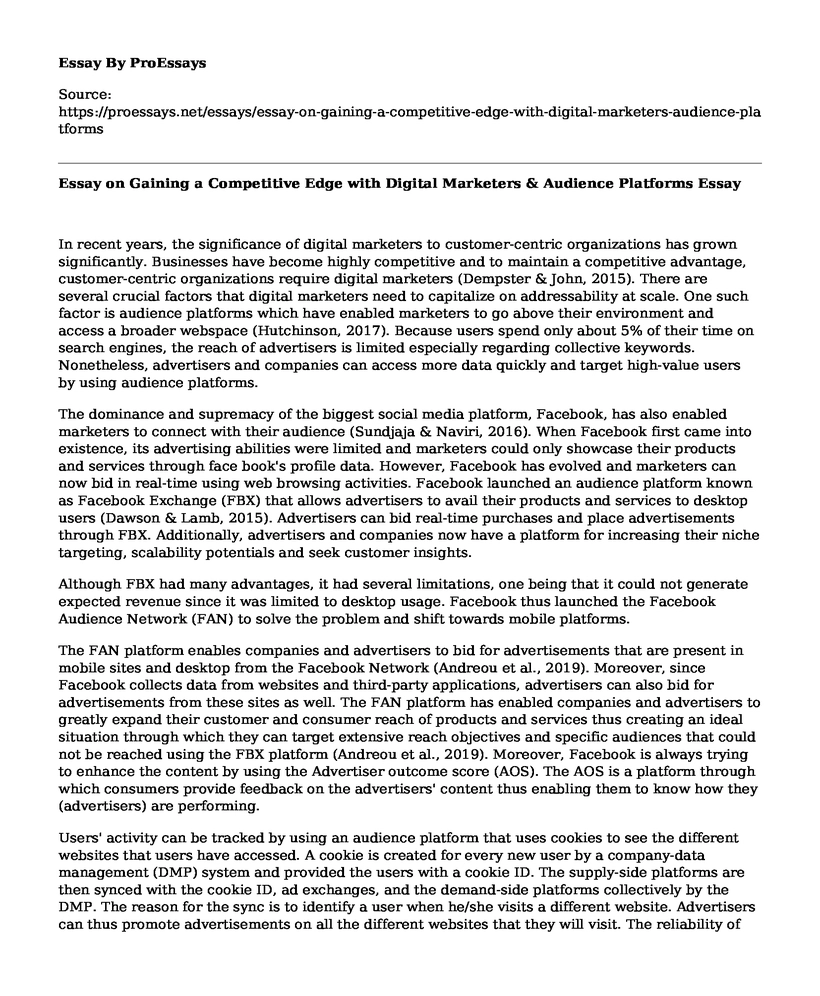In recent years, the significance of digital marketers to customer-centric organizations has grown significantly. Businesses have become highly competitive and to maintain a competitive advantage, customer-centric organizations require digital marketers (Dempster & John, 2015). There are several crucial factors that digital marketers need to capitalize on addressability at scale. One such factor is audience platforms which have enabled marketers to go above their environment and access a broader webspace (Hutchinson, 2017). Because users spend only about 5% of their time on search engines, the reach of advertisers is limited especially regarding collective keywords. Nonetheless, advertisers and companies can access more data quickly and target high-value users by using audience platforms.
The dominance and supremacy of the biggest social media platform, Facebook, has also enabled marketers to connect with their audience (Sundjaja & Naviri, 2016). When Facebook first came into existence, its advertising abilities were limited and marketers could only showcase their products and services through face book's profile data. However, Facebook has evolved and marketers can now bid in real-time using web browsing activities. Facebook launched an audience platform known as Facebook Exchange (FBX) that allows advertisers to avail their products and services to desktop users (Dawson & Lamb, 2015). Advertisers can bid real-time purchases and place advertisements through FBX. Additionally, advertisers and companies now have a platform for increasing their niche targeting, scalability potentials and seek customer insights.
Although FBX had many advantages, it had several limitations, one being that it could not generate expected revenue since it was limited to desktop usage. Facebook thus launched the Facebook Audience Network (FAN) to solve the problem and shift towards mobile platforms.
The FAN platform enables companies and advertisers to bid for advertisements that are present in mobile sites and desktop from the Facebook Network (Andreou et al., 2019). Moreover, since Facebook collects data from websites and third-party applications, advertisers can also bid for advertisements from these sites as well. The FAN platform has enabled companies and advertisers to greatly expand their customer and consumer reach of products and services thus creating an ideal situation through which they can target extensive reach objectives and specific audiences that could not be reached using the FBX platform (Andreou et al., 2019). Moreover, Facebook is always trying to enhance the content by using the Advertiser outcome score (AOS). The AOS is a platform through which consumers provide feedback on the advertisers' content thus enabling them to know how they (advertisers) are performing.
Users' activity can be tracked by using an audience platform that uses cookies to see the different websites that users have accessed. A cookie is created for every new user by a company-data management (DMP) system and provided the users with a cookie ID. The supply-side platforms are then synced with the cookie ID, ad exchanges, and the demand-side platforms collectively by the DMP. The reason for the sync is to identify a user when he/she visits a different website. Advertisers can thus promote advertisements on all the different websites that they will visit. The reliability of the platform is increased since there is hardly any traffic enabling advertisements to be fast and the costs involved low. Additionally, marketers can customize their marketing in the reporting interface and this ensures that the audience is not bombarded with the ads to the extent that it becomes irritating. Technology has changed the face of advertising and chances are that it will continue to evolve. The internet has made the world a globalized society and more and more people are now connected. Consequently, this has increased the demand for advertising enabling audience platforms to flourish.
References
Andreou, A., Silva, M., Benevenuto, F., Goga, O., Loiseau, P., et al. 2019. Measuring the Facebook Advertising Ecosystem. Proceedings 2019 Network and Distributed System Security Symposium. http://doi.org/10.14722/ndss.2019.23280.
Dawson, P., & Lamb, M. 2015. Enhanced Success with Programmatic Social Advertising. Management for Professionals Programmatic Advertising, 103-110. https://doi.org/10.1007/978-3-319-25023-6_8
Dempster, C., & John, L. 2015. The Rise of the Platform Marketer. Chapter 1: The Age of the Customer. New York: Wiley Online Library. https://doi.org/10.1002/9781119153863.ch01
Hutchinson, J. 2017. New Media Technologies and Platforms that Engage Audience Participation. Cultural Intermediaries, 135-157.
Sundjaja, A. M., & Naviri, E. 2016. The adoption of Facebook as internet marketing strategies in journal promotion. 2016 International Conference on Information Management and Technology (ICIMTech). http://doi.org/10.1109/icimtech.2016.7930330.
Cite this page
Essay on Gaining a Competitive Edge with Digital Marketers & Audience Platforms. (2023, Apr 24). Retrieved from https://proessays.net/essays/essay-on-gaining-a-competitive-edge-with-digital-marketers-audience-platforms
If you are the original author of this essay and no longer wish to have it published on the ProEssays website, please click below to request its removal:
- Groceries and Globalization Essay Example
- Christmas Decoration in Coventry Hub, UK
- Research Paper on Purchasing Products From Fukushima
- Essay Sample on Strategy Formulation
- Essay Example on Price Variations of Commodities: Challenges to Equilibrium
- Essay Example on Chobani Yogurt: Succeeding in a Crowded Business Market
- Paper Example on Internal Alignment: Improving Leadership, Efficiency & Respect







